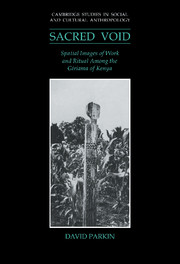Book contents
- Frontmatter
- Contents
- List of illustrations
- Preface
- Introduction
- 1 Fantasies of the west
- 2 Western Kaya, sacred centre
- 3 View from the west: cattle and co-operation
- 4 From west to east: the works of marriage
- 5 Spanning west and east: dances of death
- 6 Alternative authorities: incest and fertility
- 7 Alternative selves: invasions and cures
- 8 Coastal desires and the person as centre
- Conclusion
- Appendix 1 Three ecological zones and demographic features of southern Kilifi District
- Appendix 2 Giriama kinship and affinal terms
- Appendix 3 Giriama cattle terms
- Appendix 4 Giriama patri-clan structure
- Bibliography
- Index
- Cambridge Studies in Social and Cultural Anthropology
7 - Alternative selves: invasions and cures
Published online by Cambridge University Press: 03 November 2009
- Frontmatter
- Contents
- List of illustrations
- Preface
- Introduction
- 1 Fantasies of the west
- 2 Western Kaya, sacred centre
- 3 View from the west: cattle and co-operation
- 4 From west to east: the works of marriage
- 5 Spanning west and east: dances of death
- 6 Alternative authorities: incest and fertility
- 7 Alternative selves: invasions and cures
- 8 Coastal desires and the person as centre
- Conclusion
- Appendix 1 Three ecological zones and demographic features of southern Kilifi District
- Appendix 2 Giriama kinship and affinal terms
- Appendix 3 Giriama cattle terms
- Appendix 4 Giriama patri-clan structure
- Bibliography
- Index
- Cambridge Studies in Social and Cultural Anthropology
Summary
Vulnerability
Greenblatt (1980) may be right that the idea and possibilities of self-fashioning go back in Europe to concerns arising out of the immediate post-Renaissance era. But each age rediscovers the issue with a new urgency, and it may be suggested that the recent and current intellectual preoccupation with person and selfhood in Anglo-American anthropology (preceded by French interest, for example Mauss 1938 (1985) and Dieterlen 1973) is part of the movement of the last fifteen years or so away from the positivistic belief in the objective analysis of measurable structures governed by impersonal rules, systems and forces. Persons and selves have come to prevail over the latter.
However, we may go further than suggest the priority of personal agency and selfhood. We may suggest that selves lack permanent essences or centres, are always redefining and being redefined, and need not be an especially emphasised aspect of human thought and life: people may be culturally and in other ways highly creative without having to contemplate selves, theirs and others, in isolation from other elements of society.
Yet it is also clear that at certain times and places people do develop a marked preoccupation with questions of person and selfhood. Within our own intellectual culture, self-consciousness is itself a feature of post-modernism and, in anthropology, of post-structuralism.
- Type
- Chapter
- Information
- The Sacred VoidSpatial Images of Work and Ritual among the Giriama of Kenya, pp. 160 - 191Publisher: Cambridge University PressPrint publication year: 1991



